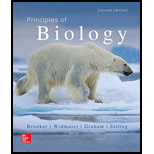
Principles of Biology
2nd Edition
ISBN: 9781259875120
Author: Robert Brooker, Eric P. Widmaier Dr., Linda Graham Dr. Ph.D., Peter Stiling Dr. Ph.D.
Publisher: McGraw-Hill Education
expand_more
expand_more
format_list_bulleted
Concept explainers
Question
Chapter 4.4, Problem 2BC
Summary Introduction
To analyze:
The different uses of flagella and cilia in protists.
Introduction:
An organism that is known to cause diseaseis called as a pathogen and its tendency to cause diseaseis known as pathogenicity. A pathogen that invades and survives inside a host has some characteristics that are distinguishable from the non-pathogenic organisms.Pathogenicity is also conferred by structures like capsule, cilia, and glycocalyx.
Expert Solution & Answer
Want to see the full answer?
Check out a sample textbook solution
Students have asked these similar questions
Standard Concentration (caffeine) mg/L
Absorbance Reading
10
0.322
20
0.697
40
1.535
60
2.520
80
3.100
Please draw in the missing answer, thank you
Please fill in all blank questions, Thank you
Chapter 4 Solutions
Principles of Biology
Ch. 4.1 - With regard to the origin of life, why are...Ch. 4.1 - Prob. 2CCCh. 4.1 - Prob. 3CCCh. 4.1 - Prob. 1BCCh. 4.1 - Prob. 4CCCh. 4.1 - Prob. 1TYKCh. 4.1 - Prob. 2TYKCh. 4.1 - Prob. 3TYKCh. 4.2 - Prob. 1CCCh. 4.2 - Prob. 1TYK
Ch. 4.2 - Prob. 2CCCh. 4.2 - Prob. 2TYKCh. 4.3 - Prob. 1BCCh. 4.3 - Prob. 1CCCh. 4.3 - Prob. 2BCCh. 4.3 - Prob. 1TYKCh. 4.3 - Prob. 2TYKCh. 4.3 - Prob. 3TYKCh. 4.4 - Prob. 1BCCh. 4.4 - Prob. 1CCCh. 4.4 - Prob. 1TYKCh. 4.4 - Prob. 2BCCh. 4.4 - Prob. 2TYKCh. 4.4 - Prob. 3TYKCh. 4.5 - What is the function of the nuclear lamina and the...Ch. 4.5 - Prob. 1BCCh. 4.5 - Prob. 2CCCh. 4.5 - Prob. 1TYKCh. 4.5 - Prob. 2TYKCh. 4.5 - Prob. 3TYKCh. 4.6 - What is the advantage of having a highly...Ch. 4.6 - Prob. 1BCCh. 4.6 - Prob. 2CCCh. 4.6 - Prob. 1TYKCh. 4.6 - Prob. 2TYKCh. 4.7 - Prob. 1TYKCh. 4.8 - Prob. 1CCCh. 4.8 - Prob. 2CCCh. 4.8 - Prob. 3CCCh. 4.8 - Prob. 4CCCh. 4.8 - Prob. 1TYKCh. 4.8 - Prob. 2TYKCh. 4.8 - Prob. 3TYKCh. 4.9 - Which of the following could be found in a...Ch. 4.9 - Prob. 2TYKCh. 4 - The cell theory states that all living things are...Ch. 4 - Prob. 2TYCh. 4 - Prob. 3TYCh. 4 - Prob. 4TYCh. 4 - Prob. 5TYCh. 4 - Prob. 6TYCh. 4 - Prob. 7TYCh. 4 - Prob. 8TYCh. 4 - Prob. 9TYCh. 4 - Prob. 10TYCh. 4 - Describe two specific ways that protein-protein...Ch. 4 - Explain how motor proteins and cytoskeletal...Ch. 4 - A principle of biology is that structure...Ch. 4 - Prob. 1CBQCh. 4 - Prob. 2CBQ
Knowledge Booster
Learn more about
Need a deep-dive on the concept behind this application? Look no further. Learn more about this topic, biology and related others by exploring similar questions and additional content below.Similar questions
- please fill in missing parts , thank youarrow_forwardplease draw in the answers, thank youarrow_forwarda. On this first grid, assume that the DNA and RNA templates are read left to right. DNA DNA mRNA codon tRNA anticodon polypeptide _strand strand C с A T G A U G C A TRP b. Now do this AGAIN assuming that the DNA and RNA templates are read right to left. DNA DNA strand strand C mRNA codon tRNA anticodon polypeptide 0 A T G A U G с A TRParrow_forward
- Please identify the curve shown below. What does this curve represent? Please identify A, B, C, D, and E (the orange oval). What is occurring in these regions?arrow_forwardPlease identify the test shown here. 1) What is the test? 2) What does the test indicate? How is it performed? What is CX? 3) Why might the test be performed in a clinical setting? GEN CZ CX CPZ PTZ CACarrow_forwardDetermine how much ATP would a cell produce when using fermentation of a 50 mM glucose solution?arrow_forward
- Determine how much ATP would a cell produce when using aerobic respiration of a 7 mM glucose solution?arrow_forwardDetermine how much ATP would a cell produce when using aerobic respiration to degrade one small protein molecule into 12 molecules of malic acid, how many ATP would that cell make? Malic acid is an intermediate in the Krebs cycle. Assume there is no other carbon source and no acetyl-CoA.arrow_forwardIdentify each of the major endocrine glandsarrow_forward
arrow_back_ios
SEE MORE QUESTIONS
arrow_forward_ios
Recommended textbooks for you
 Biology: The Dynamic Science (MindTap Course List)BiologyISBN:9781305389892Author:Peter J. Russell, Paul E. Hertz, Beverly McMillanPublisher:Cengage Learning
Biology: The Dynamic Science (MindTap Course List)BiologyISBN:9781305389892Author:Peter J. Russell, Paul E. Hertz, Beverly McMillanPublisher:Cengage Learning Biology 2eBiologyISBN:9781947172517Author:Matthew Douglas, Jung Choi, Mary Ann ClarkPublisher:OpenStax
Biology 2eBiologyISBN:9781947172517Author:Matthew Douglas, Jung Choi, Mary Ann ClarkPublisher:OpenStax Biology (MindTap Course List)BiologyISBN:9781337392938Author:Eldra Solomon, Charles Martin, Diana W. Martin, Linda R. BergPublisher:Cengage Learning
Biology (MindTap Course List)BiologyISBN:9781337392938Author:Eldra Solomon, Charles Martin, Diana W. Martin, Linda R. BergPublisher:Cengage Learning Concepts of BiologyBiologyISBN:9781938168116Author:Samantha Fowler, Rebecca Roush, James WisePublisher:OpenStax College
Concepts of BiologyBiologyISBN:9781938168116Author:Samantha Fowler, Rebecca Roush, James WisePublisher:OpenStax College Biology: The Unity and Diversity of Life (MindTap...BiologyISBN:9781305073951Author:Cecie Starr, Ralph Taggart, Christine Evers, Lisa StarrPublisher:Cengage Learning
Biology: The Unity and Diversity of Life (MindTap...BiologyISBN:9781305073951Author:Cecie Starr, Ralph Taggart, Christine Evers, Lisa StarrPublisher:Cengage Learning

Biology: The Dynamic Science (MindTap Course List)
Biology
ISBN:9781305389892
Author:Peter J. Russell, Paul E. Hertz, Beverly McMillan
Publisher:Cengage Learning

Biology 2e
Biology
ISBN:9781947172517
Author:Matthew Douglas, Jung Choi, Mary Ann Clark
Publisher:OpenStax

Biology (MindTap Course List)
Biology
ISBN:9781337392938
Author:Eldra Solomon, Charles Martin, Diana W. Martin, Linda R. Berg
Publisher:Cengage Learning

Concepts of Biology
Biology
ISBN:9781938168116
Author:Samantha Fowler, Rebecca Roush, James Wise
Publisher:OpenStax College

Biology: The Unity and Diversity of Life (MindTap...
Biology
ISBN:9781305073951
Author:Cecie Starr, Ralph Taggart, Christine Evers, Lisa Starr
Publisher:Cengage Learning

Epidemiological Studies - made easy!; Author: Let's Learn Public Health;https://www.youtube.com/watch?v=Jd3gFT0-C4s;License: Standard Youtube License